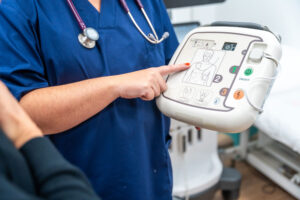
A new online tool launched in Scotland — based in part on research from the Department of Mechanical & Industrial Engineering — aims to improve survival rates for out-of-hospital cardiac arrests by improving the placement of public access defibrillators (PADs).
PADmap, which launched in March 2025, is a website designed to optimize the placement of PADs, which are also known as automated external defibrillators (AEDs). It was created via a collaboration between researchers at U of T Engineering, the University of Edinburgh and designers at creative agency Daysix. PADmap was funded by the Scottish Government and St John Scotland.
Benjamin Leung (IndE 1T6+PEY, MIE MASc 1T9, PhD 2T4), a graduate of the Applied Optimization Laboratory led by Professor Timothy Chan (MIE), incorporated aspects of the PADmap program into his PhD studies and final thesis. After receiving his PhD, Leung remains involved with the project and played a key role in turning the data into a life-saving tool.
“It’s a great feeling to launch a concrete product that incorporates my graduate studies work and turns it into a real-world problem-solving piece,” says Leung.
“Writing papers is an integral part of graduate studies but being able to turn that into a tangible result of the work is a really satisfying feeling.”
Leung first learned about Chan’s work with AEDs in Toronto during his Industrial Engineering undergraduate studies at U of T.

This research aligned with Leung’s career goals of wanting to work on cardiac arrest response. Chan had already established a connection with the University of Edinburgh to tailor his optimization model, to address the high rates of cardiac arrest in Scotland.
Funding from Mitacs Globalink gave Leung a semester at the University of Edinburgh to create and demonstrate a proof-of-concept for the tool. He worked with researchers in the University of Edinburgh’s Resuscitation Research Group, as well as the creative agency Daysix.
“If we want to maximize our resources, we need tools like PADmap to show where the data says AEDs should go,” says Leung.
“Underserviced communities with higher elderly populations benefit from AEDs and PADmap can pinpoint effective locations to place them.”
In a pilot study conducted in the city of Falkirk in Scotland, 41 AEDs were placed based on PADmap data. The team found that since implementation, they have been deployed at twice the rate compared to AEDs placed using local intuition.
With these favourable results, Leung and the PADmap team are looking forward to grow the program.
“Other parts of the UK are interested in implementing PADmap, and we would love to expand into more communities,” says Leung, who is now a research fellow at the Duke Clinical Research Institute in Durham, N.C.
“The more we can coordinate and predict where AEDs will provide the highest success rate, the more lives we can save from sudden death.”
– This story was originally published on the University of Toronto’s Faculty of Applied Science and Engineering News Site on May 14, 2025, by Kendra Hunter.